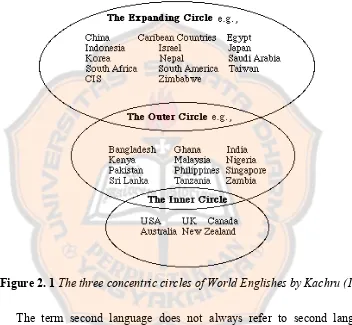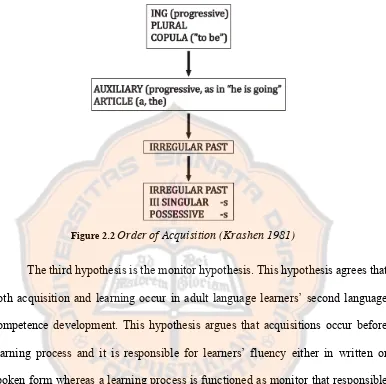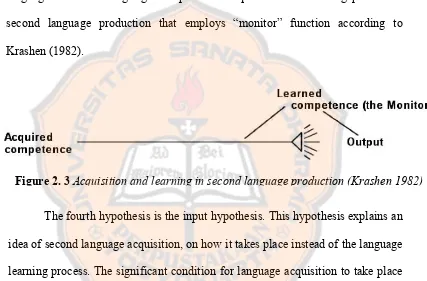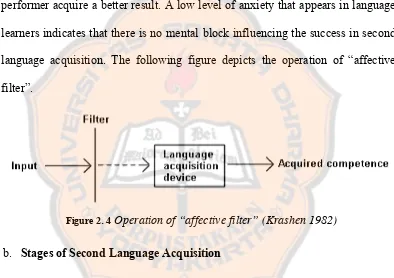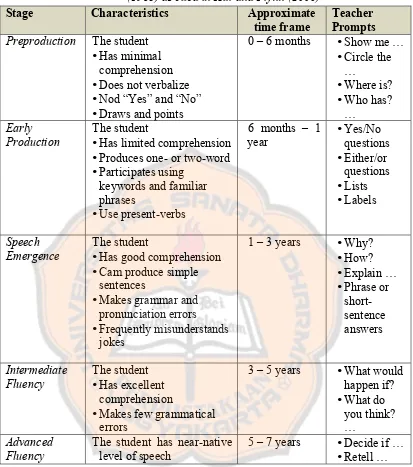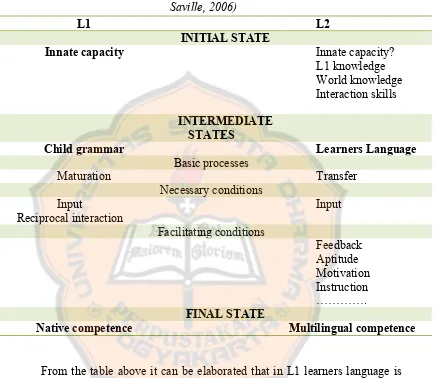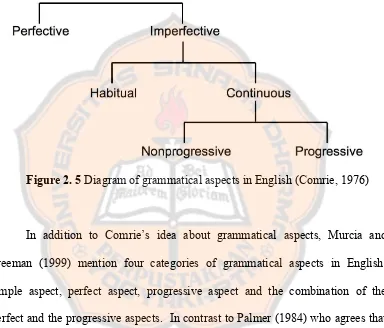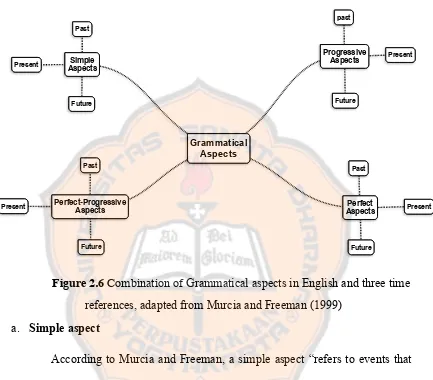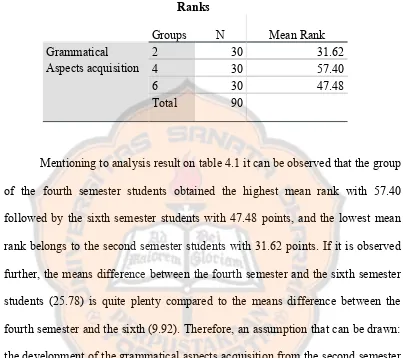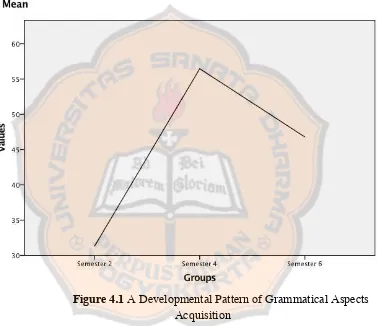ADULT LEARNERS’ DEVELOPMENTAL PATTERN OF THE ACQUISITION OF THE GRAMMATICAL ASPECTS IN ENGLISH
A THESIS
Presented as Partial Fulfillment of Requirements to Obtain the Magister Humaniora (M. Hum. ) Degree
in English Language Studies
by
Ayu Nuriyanawati 116332010
The Graduate Program of English Language Studies Sanata Dharma University
vi
ACKNOWLEDGEMENT
All praises be to Allah the almighty, the Greatest Creator ever, Who has
led me so far so I am able to accomplish my thesis. I am so grateful to have a
chance to express my gratitude for all components existing in this universe for the
never-ending supports addressed for me up to this point.
Initially, I would like to express my greatest gratitude to Dr. B. B.
Dwijatmoko, M. A., for the inspiring ideas and for allocating his time for me to
consult my thesis consistent support and reminder to finish this thesis. My
ultimate gratitude for the lecturers of the English language studies Dra. Novita
Dewi, M. S., M. A. (Hons), Ph. D., Drs. F. X. Mukarto, Ph. D., P. Sarwoto, S.S.,
M.A., Ph.D. every meeting with them has inspired me to be better. Thank you for
the opportunities given to me so that I am able to be what I am now. Additionally,
I would like to thank to my thesis reviewers Dr. J. Bismoko and Drs. F. X.
Mukarto, Ph.D. for the enlightening feedbacks to make my thesis more eligible.
Subsequently, I also thanks the vice Rector I Drs. Tarsisius Sarkim, M.Ed., Ph.D.
for the final chance given for me to complete this thesis.
For my super great and inspiring parents, the always-stay-young Ibu
Muryani and Babe Mujino and, thanks a lot! No word can express how lucky I am
to be born as your daughter. For my beloved life partner, the mischievous yet
loving Andenk, I love you to the moon and back! Glad to have your supports and
to have you. For my sisters, my super-mom sister Ajeng, and my little yet big and
charming sister Arum, you rock! Thanks for every support and encouragement,
and always believe me that I am able to finish it. For my supporting system, the
vii
For my thesis partners so called as “the fantastic-four-student of 2011”
(the most-up-to-dated Nita, the always-falling-in-love Ina, and the religious
Deasy) thanks a bunch for the constant support and reminder so that I was able to
survive the elimination stage and be a thesis survivor. “God enables us to do
anything even the one we think is the most possible one, our knowledge is limited
but God’s is infinite.” In addition, I was so fortunate to receive assistance from the
Graduate Program staff, Sanata Dharma Library staff. Thank you for being so
informative, helpful and patient with me.
viii DEDICATION PAGE
This thesis is dedicated to my beloved Ibu, Babe, and my Andenk.
ix
TABLE OF CONTENTS
TITLE PAGE ... i
APPROVAL PAGE ... ii
DEFENSE APPROVAL PAGE ... iii
STATEMENT OF WORK ORIGINALITY ... iv
PERNYATAAN PERSETUJUAN PUBLIKASI ... v
ACKNOWLEDGEMENT ... vi
DEDICATION PAGE ... viii
TABLE OF CONTENTS ... ix
LIST OF TABLES ... xi
LIST OF FIGURES ... xii
LIST OF ABBREVATIONS ... xiii
LIST OF APPENDICES ... xiv
ABSTRACT ... xv
ABSTRAK ... xvi
CHAPTER I : INTRODUCTION ... 1
A. BACKGROUND OF STUDY ... 1
B. PROBLEM LIMITATIONS ... 8
C. PROBLEM FORMULATIONS ... 9
D. RESEARCH OBJECTIVES ... 9
E. BENEFITS OF THE STUDY ... 10
CHAPTER II: LITERATURE REVIEW ... 12
A. THEORETICAL REVIEW ... 12
1. Second Language Acquisition ... 12
2. Developmental Pattern ... 26
3. Grammatical Aspects ... 32
4. EFL Learning in Indonesia ... 38
5. Review of Related Studies ... 41
x
CHAPTER III : RESEARCH METHODOLOGY ... 45
A. RESEARCH DESIGN ... 45
B. NATURE OF DATA ... 47
C. RESEARCH POPULATION AND SAMPLE ... 48
D. DATA GATHERING TECHNIQUES AND INSTRUMENTS ... 49
E. DATA ANALYSIS TECHNIQUE ... 50
CHAPTER IV : RESEARCH FINDINGS AND DISCUSSIONS ... 53
A. RESEARCH FINDINGS ... 53
1. The Developmental Pattern of Grammatical Aspect Acquisition ... 54
2. Significant Difference ... 60
3. The Problematic grammatical aspects for the EFL learners ... 66
B. DISCUSSIONS ... 68
1. The Developmental Pattern of Grammatical Aspect Acquisition ... 68
2. Significant Difference ... 70
3. Problematic Grammatical Aspects for the EFL learners ... 72
CHAPTER V ... 75
A. CONCLUSIONS ... 75
B. IMPLICATIONS ... 77
C. RECOMMENDATIONS ... 78
BIBLIOGRAPHY ... 80
xi LIST OF TABLES
xii LIST OF FIGURES
xiii
LIST OF ABBREVATIONS
EFL : English as a foreign language ESL : English as a second language ID : individual differences
L1 : first language L2 : second language
LAD : language acquisition device SLA : second language acquisition
SPSS : statistical packages for the social sciences TL : target language
xiv
LIST OF APPENDICES
xv ABSTRACT
Nuriyanawati, Ayu. 2017. Adult Learners’ Developmental Pattern of the Acquisition of the Grammatical Aspects in English. Yogyakarta: The Graduate Program in English Language Studies, Sanata Dharma University.
The absence of grammatical aspects in the Indonesian language triggers issues for Indonesian EFL learners in understanding a concept of the temporality of grammatical aspects in the English language. This study aimed at investigating the developmental pattern occurring in the adult learners’ grammatical aspects acquisition. To be specific, this study intended to investigate whether there are any significant differences in the development of the acquisition of the grammatical aspects in English of three groups of learners, the second semester, the fourth semester and the sixth semester students of the English letters department of Sanata Dharma University. Subsequently, there was an investigation on how the developmental pattern of the grammatical aspect acquisition looks like. In addition, this study also tried to observe which grammatical aspect considered as problematic by the students.
This study was a cross-sectional study. Data of this study were interval data that were obtained from a written test. A test was given to 90 students of English Letters Department of Sanata Dharma University. To analyze the obtained data, this study employed IBM SPSS software. Kruskal-Wallis H statistical operation was utilized to analyze the obtained data to develop statistical results that later could be interpreted to answer the research questions.
The interpretation of the statistical analysis results leads to the answers to the research questions. According to the analysis result, it can be interpreted that the developmental pattern of grammatical aspects acquisitions are like inverted V-shaped line. The obtained p-value of the Kruskal-Wallis test of the grammatical aspects acquisition was 0.001, and when the significance level is less than 0.05 the development of the grammatical aspects acquisitions is considered as significant.
In addition, a further investigation showed that the problematic grammatical aspect encountered by learners is the perfect-progressive aspect. The statistical data analysis result shows that the lowest score that were obtained by the students from the second, fourth, and sixth semester group were the scores of the test items related to this perfect-progressive grammatical aspect.
The observed developmental pattern of the grammatical aspect acquisitions in this study was in the form of inverted V-shaped lines. The development between the 2nd and the 4th as well as the 2nd and the 6th are significant but the development between the 4th and 6th is not significant. There is an additional finding that the development of the grammatical aspects acquisition from the second to the fourth semester students was increasing and reached its highest point in the fourth semester students group then on the sixth semester students the development of the grammatical aspects acquisition was slightly decreasing.
xvi ABSTRAK
Nuriyanawati, Ayu. 2017 Adult Learners’ Developmental Pattern of The Acquisition of The Grammatical Aspects in English. Yogyakarta: Program Pasca-Sarjana Kajian Bahasa Inggris, Universitas Sanata Dharma
Tidak adanya aspek tata bahasa di dalam bahasa Indonesia memicu masalah bagi pembelajar Bahasa Inggris Sebagai Bahasa Asing di Indonesia dalam memahami suatu konsep temporalitas dari aspek tata bahasa dalam bahasa Inggris.
Studi ini bertujuan untuk menginvestigasi pola perkembangan akuisisi aspek-aspek tata bahasa yang terjadi pada pembelajar dewasa. Secara lebih khusus, penelitian ini bertujuan untuk menyelidiki apakah ada perbedaan yang signifikan dalam perkembangan akuisisi aspek tata bahasa dalam Bahasa Inggris dari tiga kelompok peserta didik yaitu mahasiswa semester dua, empat dan enam dari Jurusan Sastra Inggris Universitas Sanata Dharma. Selanjutnya, ada penyelidikan tentang bagaimana bentuk pola perkembangan akuisisi aspek tata bahasa itu terlihat. Selain itu, penelitian ini juga mencoba untuk mengamati manakah aspek tata bahasa yang dianggap sulit oleh mahasiswa.
Penelitian ini merupakan penelitian cross-sectional. Data yang digunakan dalam penelitian ini adalah data interval yang diperoleh dari sebuah tes tertulis. Sebuah tes diberikan kepada 90 mahasiwa Jurusan Sastra Inggris Universitas Sanata Dharma. Untuk menganalisa data yang telah doperoleh, penelitian ini menggunakan perangkat lunak IBM SPSS. Operasi statistik Kruskal-Wallis H digunakan untuk menganalisis data yang telah diperoleh sehingga dapat memperoleh hasil statistik yang kemudian akan diinterptetasikan untuk menjawab pertanyaan penelitian.
Interpretasi hasil analisis statistik mengarah pada jawaban pertanyaan penelitian. Menurut haisl analisis, dapat diinterpretasikan bahwa pola perkembangan akuisisi aspek tata bahasa berbentuk garis V terbalik. Nilai p yang diperoleh dari uji Kruskal-Wallis H pada akuisisi aspek tata bahasa adalah 0.001, ketika tingkat signifikansi kurang dari 0,05 maka perkembangan akuisisi aspek tata bahasa dianggap signifikan.
Selain itu, penyelidikan lebih lanjut menunjukkan bahwa aspek tata bahasa yang sulit yang dihadapi oleh peserta didik adalah aspek “perfect-progressive”. Hasil dari analisis data statistik menunjukkan bahwa nilai terendah yang diperoleh oleh mahasiswa dari kelompok mahasiswa semester dua, empat, dan enam adalah nilai dari item tes yang berhubungan dengan aspek tata bahasa “perfect-progressive”.
xvii
signifikan. Ada sebuah temuan tambahan bahwa terdapat peningkatan pada perkembangan akuisisi aspek tata bahasa dari mahasiswa semester dua ke dan perkembangannya mencapai titik tertinggi pada tingkat mahasiswa semester empat dan kemudian sedikit menurun pada mahasiswa semester enam.
1 CHAPTER I INTRODUCTION
This study aimed at investigating the developmental pattern of aspects
acquisition by English adult learners, particularly the English language learners of
the English Letters Department of Sanata Dharma University. This study
investigated the developmental pattern of grammatical aspect that is not present in
learners' first language, the Indonesian language.
This chapter discusses information related to this study; the background of
the study that tells about the underlying idea of this study as well as the problem
limitation and problem formulation section that discusses the main problem of this
study as well as the limitation to make the study more focus on a certain issue.
Furthermore, there are also research objectives to point out the main goal of this
study. The last part of this section is the benefit of the study that explains the
advantage of this study for the researcher and also for the readers.
A. BACKGROUND OF STUDY
As an international language, the English language is acknowledged in
almost all parts of this world. Whenever we go in this world we can find the
English-speaking people. Therefore, knowing and mastering the English language
can make one able to communicate with more people and get more benefits from
it. When establishing communication with other people, it will be easier when the
people use the English language as international language especially if the
2
Moreover, the English language can be functioned as a communication bridge to
make people from different language background able to exchange their ideas and
communicate with each other.
Nowadays the use of the English language has reached a wider scope, it is
not only used as a medium of communication in countries that use it as the first
language but also in countries that use the English language as their second as
well as foreign language. The geographical spread of English has made English
becomes more important day by day (Fishman, 1977). The importance of the
English language is not merely determined by a large number of its speakers but
also its high frequency in the world communication and any other aspects such as
business, e-commerce, and education as well as in other life aspects.
According to Kachru (1985), as cited in Rajadurai (2005), the English
speaking countries are divided into three concentric circles: the inner circle, the
outer circle, and the expanding circle. Countries that belong to inner circle are
those Native-English speaking countries that use the English language as their
first languages such as United States of America, Canada, New Zeeland and the
United Kingdom. The outer circle countries are for the countries that were
colonized by British so that the English language becomes their second language.
It is also as a part of the English invasion of non-native countries. Countries that
belong to this circle are Philippines, India, Kenya, Singapore, Malaysia and other
English colonies. Expanding circle countries are the countries in which the
English language is as a foreign language. In these countries, the English
3
Based on Kachru's theory, Indonesia is categorized as a part of expanding
circle countries for English position as a foreign language. Even though the
English language has become a foreign language in Indonesia but there is also a
rising of awareness in using English as lingua franca. However, there are not so
many English-speaking people in Indonesia compared to other ASEAN
neighboring countries such as Brunei Darussalam, Malaysia, or Singapore. Being
a foreign language in Indonesia, the English language does not play a major role
in the community and it is primarily learned in classroom. Moreover, according
to Satono (1997) as cited in Musthafa (2009) there is also political agenda
regarding official status of English in Indonesia that "English is not and will never
be a social language nor the second official language in Indonesia". That political
agenda is one of the reasons why in Indonesia there are not so many people use
English as their means of communication in their daily life. Commonly, English is
only used at certain places such as in offices or in classrooms.
The development of language acquisition of language learners deals with
regularities occurs in the process of language learning experienced by the
language learners. As stated by Ellis (2008) the term developmental pattern of
language acquisition, particularly the second language, refers to general
regularities that noticeably occurring in language acquisition. It means that
developmental pattern is obtained by collecting evidence to find out observable
regularities that occur during acquisition process of a new language. By obtaining
the pattern then it is possible to see the stages taken by the language learners
during their TL acquisition. According to Ellis, the order of mastery of different
4
a single TL structure can be used to observe the developmental pattern of
language learners.
In order to investigate the developmental pattern, it is necessary to employ
correct and appropriate methods to get the most accurate investigation result.
Therefore, there are methods in investigating developmental pattern that can be
carried out to obtain stages of acquisition. Ellis (2008) proposes several methods
to investigate the developmental pattern; they are obligatory occasion analysis,
target-like use analysis, frequency analysis, and implicational scaling.
Language is unique and its uniqueness can be seen from its grammar.
Palmer (1984) mentions three characteristics of language that are important for
understanding the nature of grammar: its complex, productive and arbitrary
characteristics. Language is complex given the fact that when translating a
language to another language requires complexity in understanding the grammar
of each language; even if the translation tool is utilized the translation result is not
completely satisfying. Language is productive as there is a possibility of creating
new sentences with new words each time that is not merely imitated and it is
agreed by Palmer that we have something like sentence-producing mechanism.
Language is arbitrary; there is no one-to-one relation between sound and meaning.
This is evidence that languages differ and it occurs in most of all in the language
grammatical structure.
Language is unique therefore each language has different grammatical
form and formula. According to Quirk et al. (1972), grammar is a complex set of
rules specifying the combination of sound or spelling which combine sound or
5
produce a large unit as the combination of sound and spelling. In addition to that,
Greenbaum and Nelson (2002) proposes an idea about grammar, according to
them grammar is a set of rules that allowing us to combine words in our language
into larger units. As the center of language, it mediates between the system of
sound or of written symbols, as well as the system of meaning.
Even though most languages have a grammatical system but Palmer
(1984) argues that some languages have grammar, others do not. Palmer took an
example of English and Chinese languages; he said that the Chinese language has
no grammar because in the Chinese language all words keep the same shape. It is
different with the English language; there are a few different forms of words in
the English language. In the English grammatical system, there is a phenomenon
what so called as a tense. In which the words' shape changes according to the
tenses. Compared to English, there is no grammatical marking in the Indonesian
language. According to Dahl (1985), there are no perfective and imperfective
grammatical aspects in the Indonesian language. Other than that, Dahl also adds
that the Indonesian language also does not have past tense, inflectional future, as
well as perfect form. Therefore, the concept of tenses and particularly
grammatical aspect become a new idea for the Indonesian EFL learners.
A tense is used to indicate the time when an action or event takes place or
when a state or process holds. A tense refers to the moment of speaking.
According to Palmer (1984), morphologically, there are only two tenses in the
English language, past and present. Whereas the future is not considered as a
tense because in order to refer to the future time the verb requires another word
6
is taking a place in the past, in the present or in the future time. The different
indication is created by modifying the verbs by adding or altering the verbs with
additional morpheme such as -ed (Hamm and Bott, 2014).
In addition to English tenses, there is also another feature in the English
language that is not present in the Indonesian language i.e. the grammatical aspect
that different from tenses. According to Quirk (1972), grammatical aspect refers
to a manner in which the verb action is regarded or experienced. It means that the
grammatical aspects show how the action verb indicates the occurring experience.
Palmer (1984) argues that in many languages there is an aspect instead of a tense,
a tense refers to time while aspects refer to completion, duration, and similar
concept. The choice of an aspect is a comment on or a particular view of the
action. Grammatical aspects indicate the temporal state of an action. In brief, the
grammatical aspect describes the duration of an action takes place in with a
particular tense. A grammatical aspect gives a feeling about a verb, about the
action of a verb whether the action is happening at the moment of speaking, still
happening, connecting with the past time or in brief it tells us whether the action
is continuing or finished. Moreover, according to Comrie (1976), a grammatical
aspect provides a way in interpreting temporal constituency of a situation. Dahl
(1985) categories the grammatical aspects into perfective: imperfective,
progressive and habitual activities.
Language acquisition has a slightly different meaning with language
learning. According to Krashen (1981), the language acquisition and language
learning are different in the consciousness of the learners. In language learning,
7
learn on how to use them correctly. In contrast, in language acquisition, the
language acquirers unconsciously acquire the language. They do not notice about
language rules and systems; they are usually exposed by the language and get the
unconscious result of the exposure.
There are numbers of studies on the acquisition of the English language
aspects. Rahman and Ali (2015) conducted a study on problems faced by
Bangladesh EFL learners in acquiring the English language tense and aspects.
The study reveals the problem faced by Bangladesh EFL learners in mastering
English tense and aspects is due to the interference of their L1 rule. The different
grammatical system of EFL learners' first language and the English language
influence the students' understanding on the concept of aspects in the English
language system. Rahayu (2015) conducted a study on the English progressive
aspects focused on the construction of be+V+ing. The study shows that students'
problems lie in the understanding the meaning of English progressive while the
understanding on simple aspects is not problematic for the students. To
understand the grammatical aspects means to understand a temporal state of an
action, a study by Zhao and Juan (2011) on the influences of L1 and lexical
aspects in the temporal acquisition of the Chinese and Japanese EFL learners
shows that L1 influence becomes an active factor in the Japanese learners'
progressive marking performance. On the other hand, the L1 influence was not an
active factor in Chinese learners. It shows that understanding temporal states or
aspects can be problematic because of the interference of L1. As showed by
Bardovi-Harlig (2000); Gabriele (2009); Montrul & Slabakova (2002) in
8
showing that L2 learners facing difficulties in acquiring English tense and aspects
properties due to morphosemantic inconsistency between their first language and
second language. Learners who have already been exposed with L1 will tend to
use their L1 rule over the L2 rule.
B. PROBLEM LIMITATIONS
In investigating the adult learners' developmental pattern of the
grammatical aspects in the English language, the cross-sectional study is
employed. According to Cohen et al. (2000), a cross-sectional study collects data
that deals with a time-related process from the different group at a point in time
while longitudinal studies collect data from the same group at different points in
time. Numerous studies conducted to find the developmental pattern on a certain
issue in language acquisition that uses longitudinal data collection method. It
aimed at obtaining intensive data of a group of study objects in a certain period of
time. This kind of study has disadvantages; one of them is time-consuming. In
contrast with a longitudinal study, cross-sectional study is not time-consuming as
it is conducted at a single point of a time.
Given the fact that the population of this study consists of the students of
the English Letters Department who need at least four years or eight semesters to
complete the program then it will take a long time to observe the developmental
pattern with the longitudinal study. Consequently, this study used a
cross-sectional method to obtain data in a more efficient time. Instead of using a sample
group, this cross-sectional study using three sample groups from three different
9
As mentioned before, the focus of this study is on the acquisition of
grammatical aspects in the English language by the Indonesian EFL learners
particularly students of the English Letters Department of Sanata Dharma
University. The grammatical aspects were selected as there are previous studies
showing that many language learners meet difficulties in understanding the
concept of temporal state in the English language grammatical aspects. Therefore,
a more comprehensive study on grammatical aspects acquisition of EFL learners
is necessary to be carried out in order to provide an additional source of
information about this topic.
C. PROBLEM FORMULATIONS
Given the background of study as well as the problem limitation, this
study was carried out to provide answers to these following research questions:
1. What is the developmental pattern of the acquisition of the grammatical
aspects in English of the second, fourth and sixth semester students of the
English Letters Department?
2. Is there any significant difference in the development of the acquisition of
grammatical aspects of those three groups of students?
3. What grammatical aspects in English are problematic to them?
D. RESEARCH OBJECTIVES
This study aimed at providing answers and elaborated discussions on the
adult EFL learners' developmental pattern on the grammatical aspect acquisition.
As mentioned in the background of study that the grammatical aspects in the
10
whose first language has a completely different grammatical system in which the
grammatical aspects is not present. For Indonesian adult EFL learners, the
absence of the grammatical aspects in the Indonesian language system could be
problematic. Since most of the previous researches were about EFL learners but
there is not any comprehensive research on grammatical aspects acquisition of
Indonesian EFL learners then there is a gap of study to be completed.
Therefore, referring to the research questions presented in the previous
section, the first objective of this study is to obtain detailed information about the
Indonesian adult learners' developmental pattern of the acquisition of the
grammatical aspects in the English Language. Next, the second objective is to find
out whether there is any significant difference in the mastery of grammatical
aspects among the adult EFL learners, particularly the students of the English
Letters department from the second, fourth and sixth semesters. Finally, the third
objective is to find out which grammatical aspects in English are problematic for
each group of those adult learners. Supplementary, it investigated whether each
group has a similar problem in certain grammatical aspects or, alternatively, each
group has its own problematic grammatical aspects.
E. BENEFITS OF THE STUDY
The main purpose of conducting this study is to add a contribution to the
study of the developmental pattern of EFL learners in acquiring the grammatical
aspect in the field of second language acquisition. Second language acquisition
deals with an acquisition of languages other than the learners' native language. In
this study, the second language refers to the English language for the Indonesian
11
Indonesian EFL learners understand the word structures that indicate different
aspects in the sentence. This study is expected to provide theoretical and practical
benefits for the readers, writers and other parties who read and use this research
for their future studies, especially for those who are interested in the study of the
acquisition of the grammatical aspects of the English language by the Indonesian
EFL learners.
Theoretically, the study is expected to provide more information and to
construct a better understanding on the developmental pattern of the English
language aspects acquisition. Subsequently, this study focused on providing
comprehensive information about the order of acquisition in the developmental
pattern of the grammatical aspects in the English language. Practically, by
knowing the developmental pattern of the English language aspects acquisition by
EFL learners could help either the teachers or students of EFL learners to reflect
and improve their performances in understanding the concept of the grammatical
aspects in the English language. Hence, by comprehending the problematic
grammatical aspect in the English language the language learners become more
aware and able to overcome any difficulties in understanding and using the correct
12 CHAPTER II LITERATURE REVIEW
There are two main sections in this chapter. The first section, the
theoretical review, provides information about theories as the scaffolding of this
study. Hence, this chapter aimed at elaborating the constructs in this study,
namely second language acquisition, developmental pattern, grammatical aspects
in the English language, as well EFL learning in Indonesia. The second section is
the theoretical framework of the study as the theoretical background or rationale
to elaborate the relationships among variables of this study.
A. THEORETICAL REVIEW
This section presents interrelates constructs adapted to provide information
about the topic of this study. Hence, this theoretical review also gives in depth
analysis of each construct to provide a comprehensive knowledge. Subsequently,
review of the related studies aimed at contextualizing this study with current
existing studies.
1. Second Language Acquisition
To get a robust understanding of second language acquisition there are
three sub-sections elaborating three main ideas on second language acquisitions
the concept, stages and the influencing factors in second language acquisitions.
a. Concept of Second Language Acquisition
Discussing the language acquisition, there are two major concepts that
13
The first language acquisition refers to the acquisition of a native language in
language learners at the early age while the second language acquisition refers to
the language acquisition other than learners’ native language that occurs in adult
learners. Since this study focuses on acquisition by adult Indonesian EFL learners,
then this sub-section only focuses on the acquisition of second language
experienced by adult learners
The term second language does not always refer to second language
learned by language learners. The terms second language may also refer to third
or fourth language other than learners’ native language. As seen in figure 2 about
Kachru’s concentric circle (1985) Indonesia belongs to expanding circle country
group, in which English is as a foreign language. Even though according to that
concentric circle English is not as a second language in Indonesia, in this study
employs theories on second language acquisition because this study concerns
14
about the acquisition of language other than the learners’ native language. Gass
and Selinker (1994) argue that an important aspect of second language learning is
that the second language learning refers to the learning of a language after
learning of the native language. They also add that the acquisition of a second
language may take place in classroom as well as in more natural situation. In other
words, the second language acquisition is possible to happen in guided or
unguided situations.
Second language acquisition studies are not only can be applied to
individual language learners but the studies can also be applied to groups as
claimed by Saville and Troike (2006) that “SLA refers both studies of individuals
and groups who are learning a language subsequent to learning their first one as
young children and to process of learning that language”. Further, Saville and
Troike also add that the context of second language acquisition includes learning
process in both formal and informal situations. According to Klein (1986), “a
second language can be acquired in a variety of ways, at any age for different
purposes, and to varying degrees”. It implies that it supports the idea of second
language learning that may be occurring in formal and informal situations with
various learners age as well as various learning purposes. That statement also
indicates that Klein agrees about the idea of guided and spontaneous language
acquisition in SLA. The guided language acquisition emphasizes the idea of SLA
in a classroom with a teacher to guide the language learners in acquiring the
second language. While the spontaneous language acquisition accentuates the
15
that makes them acquire the second language in a spontaneous way without any
exposure on the rules about the language.
In contrast to the concepts of second language acquisition presented
above, Krashen (1981) makes a distinction between a language acquisition and
language learning. The language acquisition refers to an unconscious process,
which involves a meaningful interaction in the target language in a natural
communication. It means that the language learners do not concern about the
grammatical rules of the target language. The learners only focus on conveying
the meaning and there is no error correction as well as explicit teaching (Brown
and Hanlon, 1970; Brown, Cazden, and Bellugi, 1973 as cited in Krashen 1981).
This subconscious language acquisition produces the learners who are not aware
of the language rules. On the other hand, the term conscious language learning
means that the learners consciously learn about the grammatical structures of the
target language. The teachers provide error correction and presentation of explicit
rules. In addition, language learning commonly occurs in a more formal situation
such as in the classroom. The result of this language learning is that the language
learners become conscious and aware of the rules of the target language.
In addition to the concept about second language acquisition mentioned
before, Krashen (1982) proposes five main hypotheses 1) the acquisition-learning
distinction, 2) the natural order hypothesis, 3) the monitor hypothesis 4) the input
hypothesis and 5) the affective filter hypothesis. The first hypothesis is the
acquisition-learning distinction. The points highlighted in this hypothesis are the
relationships between language acquisition and language learning. This
16
competencies in a second language. Therefore, in this first hypothesis, Krashen
points out the differences of the terms learning and acquisition. Language learning refers to the way of learners developing competencies of the second
language in a formal condition. It gives chances to the learners to become
conscious and aware of the rules or grammars of the second language. In a
learning process, the language grammars are explicitly learned and as a result, it
makes the learners understand the second language.
In contrast to language learning, language acquisition refers to the way of
learners developing competencies of the second language in informal ways.
Language acquirers are not explicitly exposed to rules and grammars of the
second language; consequently, the acquisition process is a subconscious process.
In a language acquisition, the acquirers are aware of the second language
grammatical form instead of the use of the second language for communication.
When language acquirers have developed the competencies of second language,
they will have a “feel” off correctness that will help them to sense whether the
sentences they make are correct or not.
The second hypothesis is the natural order hypothesis. In formulating this
hypothesis, Krashen refers to several prior research findings. Krashen states,
“Grammatical morphemes seem to be acquired in a natural order. Some structures
are acquired earlier and some later”. In other words, the acquisition of the rules of
a language happens in predictable order.
According to this second hypothesis, the natural order occurs in both
17
shows the average order of acquisition of grammatical morphemes for English as
a second language, from both children and adult learners by Krashen (1977).
The third hypothesis is the monitor hypothesis. This hypothesis agrees that
both acquisition and learning occur in adult language learners’ second language
competence development. This hypothesis argues that acquisitions occur before
learning process and it is responsible for learners’ fluency either in written or
spoken form whereas a learning process is functioned as monitor that responsible
for correcting the misuse of grammatical rules. Language learning plays its role as
a monitor because acquisition has taken place before the learning occurs. The
monitoring role can be performed by other learners or by the learners oneself
(self-correction). Krashen differentiates language learners according to learners’
individual variation into three types of learners 1) over-users, occurs when
language learners use the ‘monitor’ function all the time, 2) under-users, happens
to the learners who have not learned about language rules or those who prefer not
18
to use their “monitor” function and 3) optimal users, it is when learners use their
“monitor” function appropriately. Briefly, there are three specific conditions in
this hypothesis: time, focus on form and know the rule. There are some
constraints to successfully be a “monitor”, first the language acquirer has to know
the rule; second, it is necessary for the acquirer to think about the correctness or
focus on the form. In addition, an acquirer must have time to monitor their spoken
language. The following figure depicts the acquisition and learning process in
second language production that employs “monitor” function according to
Krashen (1982).
The fourth hypothesis is the input hypothesis. This hypothesis explains an
idea of second language acquisition, on how it takes place instead of the language
learning process. The significant condition for language acquisition to take place
is that when the acquirer comprehends the input language that contains structures
“a bit beyond” acquirer’s current level of competence. For example, when an
acquirer’s level of competence is at level “i” then the acquisition takes place
when the acquirer is exposed to comprehensible input that is considered at level
“i+1”. Krashen also emphasizes that acquirer who has been exposed to a
comprehensible input later will progress and improve their language competence
along with the natural order.
19
The fifth hypothesis is the affective filter hypothesis this hypothesis was
proposed by Dulay and Burt (1977), as cited in Krashen (1982), this hypothesis
counts the affective factors’ role in second language acquisition. Krashen
mentions three types of affective variables influencing the success in second
language acquisition they are motivation, self-confidence, and anxiety. A highly
motivated language performer generally does better in second language
acquisition. A high self-confidence and a good self-image tend to make a
performer acquire a better result. A low level of anxiety that appears in language
learners indicates that there is no mental block influencing the success in second
language acquisition. The following figure depicts the operation of “affective
filter”.
b. Stages of Second Language Acquisition
In both first and second language acquisitions, there are many processes
experienced by the language learners before they are able to use the language as a
means of communications. Haynes (2007) beliefs that “all new learners of the
English language developing through the same stages to acquire a language.
However, the length of time of each student spends at particular stages may vary
greatly”. That is why the success of second language acquisition is more various
compared to the first language acquisition.
20
There are many models of the processes in second language acquisition;
one of them is a natural approach. It is one of the simple models based on the
teaching approach. In this approach, Krashen and Terrell (1983) propose five
basic stages of second language acquisition. 1) pre-production, 2) early
production, 3) speech emergence 4) intermediate fluency and 5) advanced
fluency.
The first stage is the pre-production stage that is also said to be a silent
period where the learners have limited comprehension. Their level of vocabulary
is around 500 words. Most of the learners will use keyword and similar phrases as
well as present-tense verbs. Another characteristic of learners in this stage is that
they have limited comprehension and they tend to produce one or two-word
responses. It occurs due to their limited vocabulary as well as grammatical
knowledge because their most commonly used verb is present-tense verbs.
Therefore, in this stage, the learners seem to be silent learners due to their lack of
productive skills. Therefore, the teachers’ prompt in this stage is only in a form of
simple instruction such as ‘show me…, point the ….” Hence, to respond the teachers’ prompt, the students only need to use small amount of their productive
skill.
The second stage is early production stage in which the learners gradually
increase their vocabulary level into around 1000 words and they begin to be able
to create short language forms although it is not yet correct. The learners start to
be able to use their productive skill although it is only in small amount. In this
stage teachers can use the yes/no question, either/or questions or show the
21
The third stage is called as speech emergence. Learners in this stage have
already had at least 3000 words in their vocabulary and they start to produce short
sentences and simple phrases. Their productive skills are developing as their
ability to produce longer and more complete sentences increase. When these
language learners start to produce sentences, they also start to make grammars and
pronunciations errors. In addition, they also begin to be able to initiate
conversations and make inquiries or small questions. Their receptive skills are
also developing; they begin to understand short stories with help from images or
pictures related to the stories. As the time goes, their understanding is getting
better although they sometimes still misunderstand some information. Teacher can
use a more complex instructions or questions for the students at this level. The
question words that can be used as the teachers’ prompt such as why and how.
The fourth stage is called as intermediate fluency in which the learners are
progressing and get a much better comprehension. Their productive skills are also
getting better and they make less grammatical errors compared to those in the
speech emergence stage. Learners’ vocabulary level reaches around 6000 words
and it helps the learners to be more productive, they can produce more sentences.
The last stage is the advanced fluency in which the learners have acquired a
near-native level of speech. They have excellent productive skills as well as receptive
skills.
The following table shows the stages of second language acquisition by
Krashen and Terrell (1983) as cited in Hill and Flynn (2006). There are stages,
characteristics, approximate time frame as well as the teachers’ prompt that
22
Table 2.1 The Stages of Second Language Acquisitions by Krashen and Terrell (1983) as cited in Hill and Flynn (2006)
Stage Characteristics Approximate
time frame
Teacher Prompts Preproduction The student
•Has minimal comprehension
•Does not verbalize
•Nod “Yes” and “No”
•Draws and points
0 – 6 months •Show me …
•Circle the …
•Where is?
•Who has? …
Early Production
The student
•Has limited comprehension
•Produces one- or two-word
•Participates using keywords and familiar phrases
•Use present-verbs
6 months – 1 year •Yes/No questions •Either/or questions •Lists •Labels Speech Emergence The student
•Has good comprehension
•Cam produce simple sentences
•Makes grammar and pronunciation errors
•Frequently misunderstands jokes
1 – 3 years •Why?
•How?
•Explain …
•Phrase or short-sentence answers Intermediate Fluency The student
•Has excellent comprehension
•Makes few grammatical errors
3 – 5 years •What would happen if?
•What do you think? …
Advanced Fluency
The student has near-native level of speech
5 – 7 years •Decide if …
•Retell …
In addition to the five stages of second language acquisition as proposed
by Krashen and Terrel, Saville and Troike (2006) propose three stages occurring
in both first and second language learning. They state that in general there are
three phases in language learning, it occurs in both L1 and L2 learning. The
phases are the initial state, intermediate state, and final state. Saville and Troike
23
differences in first and second language learning that makes it important to dig out
more information on how the second language is acquired. This table compares
three states occurring in L1 and L2 development.
Table 2.2 Comparison between first and second language development (Troike - Saville, 2006)
L1 L2
INITIAL STATE
Innate capacity Innate capacity?
L1 knowledge World knowledge Interaction skills
INTERMEDIATE STATES
Child grammar Learners Language
Basic processes
Maturation Transfer
Necessary conditions Input
Reciprocal interaction
Input
Facilitating conditions
Feedback Aptitude Motivation Instruction ………….
FINAL STATE
Native competence Multilingual competence
From the table above it can be elaborated that in L1 learners language is
innate, as stated by Chomsky (1957) that language can only be accounted for by
an innate, biological language acquisition device (LAD) or system. It is also
believed by Chomsky that infants universally possess an innate “grammar
template”, or universal grammar. With this innate ability, the infants will be able
to pick out the grammatical rules of the language they hear spoken around them as
they gradually construct the grammar of their mother tongue. For the second
24
influencing the acquisition such as L1 knowledge, word knowledge as well as
interaction skills.
The next stage proposed by Saville and Troike is intermediate states in
which the learners need to pass before they arrive at the final state. In this stage,
the learners experiencing process in a direction to acquire either L1 or L2. Troike
and Saville mention that there is a similarity in the L1 and L2 acquisition. The
basic process of child grammar is by means of maturation. Their acquisition is
getting better since they become more mature. Its development is spontaneous and
it involves an unconscious process. Children do not need to learn about
grammatical rule explicitly because when they are exposed to the language they
will unconsciously learn how to use the language. In this kind of acquisition, a
cognitive maturity plays a significant role. In second language acquisition, most
of the learners are already mature and the cognitive maturity is no longer as
significant aspect in the success of the L2 acquisition. Interlanguage development
involving several processes one of them is ‘transfer’, which divided into two
types: 1) positive transfer and 2) negative transfer. The transfers involve the use of
their first language rules. Positive transfers occur when there are similarity of
rules or structures in L1 and L2 then when it the L1 rules is implemented by the
learners in L2 the use is appropriate or acceptable. In contrast, negative transfers
occur when the L1 structures are not acceptable to be implemented in L2 and they
are considered as an error.
After experiencing the intermediate states, both L1 and L2 learners come
25
L2 learners. For L1 learners, the goal of this state is to achieve a native linguistic
competence while for L2 learners the goal to achieve a multilingual competence.
c. Influencing factors in Second Language Acquisition
Language learners are unique and their distinctiveness has resulting
different success in language skill achievement. It is agreed by Shoebottom (n.d.)
that some of the language learners might learn faster and easier to achieve the
language competence than the other, and some of them might need longer time to
achieve it. This commonly occurs in the first language as well as the second
language learning. Some of the language learners who have high motivation to
learn will probably achieve the language competencies faster with a better result.
In contrast, a language learner with lower motivation will not perform as good as
other language learners with higher motivation and determination.
Particularly in second language acquisition, these varieties occur as a
result of several influencing factors. Ellis (1985) mentions several influencing
factors in second language learning such as age, aptitude, intelligence, cognitive
style, attitudes, motivation, and personality. In addition, Dornyei (2005) comes up
with an idea about Individual Differences (ID) which including the influencing
factors in the second language acquisition. According to Dornyei, ID “concerns
on anything that marks a person as a distinct and unique human being”. To be
more specific, the ID refers to “dimensions of enduring personal characteristics
that are assumed to apply to everybody and on which people differ by degree”. In
a case of second language learning, Dornyei highlights several important IDs such
as personality, temperament, mood, language aptitude, motivation,
26
student self-regulation. Other that those IDs, Dornyei also adds anxiety, creativity,
willingness to communicate, self-esteem and learners beliefs as influencing
factors in the success of second language acquisition.
In addition to Dornyei’s idea about IDs as influencing factors in language
acquisitions, Cann (1992) beliefs that “ the most important factors in English as
the second language are age, intelligence, the amount of English spoken at home,
pupil perception of parental support and first language acquisition.”
Comparatively, both Cann and Ellis mention age and intelligence as influencing
factors in second language acquisitions. They both agree that those two factors are
playing significant role in the learners’ second language acquisitions processes.
2. Developmental Pattern
a. Concept of Developmental Pattern
The noun phrase “developmental pattern” consists of two words,
developmental and pattern. The word developmental can be broken down into
development-al. According to Oxford American Dictionary and thesaurus (2009), the word “development” refers to “the act or an instance of developing; the
process of being developed; a stage of growth and advancement.” Added with
suffix –al then it becomes developmental which based on Oxford American
dictionary and thesaurus it means “incidental to growth”. Furthermore, the Oxford
American dictionary and thesaurus describes the word “pattern” as “a regular or a
logical form, order or arrangement of parts”. Therefore, the phrase developmental pattern can be literally described as an order of arrangement of a stage of growth and advancement. In addition, the developmental pattern of the acquisition of
27
stage of growth and advancement in acquiring the grammatical aspects in the
English language.
According to the results of previous researches of the learners’ language
on second language acquisition, Ellis (2008) claims “L2 acquisition proceeds in a
regular, systematic fashion. Moreover, Ellis also states that the terms
developmental pattern of language acquisition refer to “general regularities
evident in language acquisition”. It means that developmental pattern is obtained
by collecting the evidence to find out observable regularities that occur during an
acquisition process of a new language. By obtaining the observable pattern then it
is possible to see the stages taken by the language learners during their second
language acquisition process.
The terms developmental pattern in second language acquisition include
two concepts of an order and a sequence. According to Ellis (2008), to the order
of acquisition is important to identify whether the learners’ acquire some target
language features before others. In contrast to the order of acquisitions, the
sequence of acquisitions related to how learners acquire particular linguistic
features in a target language. A study on Spanish and Chinese children on
‘natural’ spoken data by means of bilingual syntax measure by Dulay and Burt
(1973) as cited in Ellis (2008) revealed the acquisition order for a group of
English morphemes remained the same irrespectively of the learners’ L1 or of the
scoring method. There are also several studies showing that there is a standard
‘acquisition order’ that is quite similar ignoring some factors such as learners’ L1,
28 b. Stages in Developmental Pattern
There are some perspectives in viewing the developmental pattern of
second language acquisition. Smith & Truscott (2005) as cited in Ellis (2008),
distinguish the perspectives into two: the developmental perspectives and the
linguistic perspectives. The first perspective views acquisition as gradual
processes with overlapping stages while the second perspective views acquisition
as a movement of a rule system from one to another rule system. In this section,
the stages in developmental pattern of second language acquisition are viewed
from developmental perspectives.
In a developmental perspective, a developmental pattern of language
acquisition is divided into early stages, the acquisition of grammar and
morpheme, the acquisition of vocabulary and the acquisition of phonology.
According to Ellis, there are three main aspects of the early L2 acquisition: silent
period, formulaic sequence, and also structural and semantic simplification. Silent
period is obligatory in L1 acquisition but in L2 acquisition it is not obligatory
since the learners already familiar with the language and they have acquired one
language other than the target language. Nevertheless, there were several
researchers such as Itoh and Hatch (1978), Hakuta (1978), Saville-Troike (1988)
and Hanania and Gradman’s (1977) as cited in Ellis (2008) find some subjects of
their L2 studies experiencing silent period. According to the naturalistic setting,
the next aspect of an L2 acquisition is a formulaic sequence that happens very
common in L2 acquisition in early stages. Lyons (1968) as cited in Ellis (2008)
describes formulaic sequences as “expressions which are learned as unanalysable
29
the structural and semantic simplification in which the L2 learners tend to omit
the grammatical function words such as auxiliary verbs.
The following stages of language acquisition in developmental
perspectives are the acquisitions of grammatical morphemes particularly on the
orders and sequences of language acquisitions. The main attentions of these stages
are the morpheme studies, the acquisition of tenses and aspects as well as the
acquisition of syntactic structures. The focus of morpheme studies is only on the
order of acquisitions of grammatical functors, it does not focus on the sequences.
Most of the morpheme studies employ cross-sectional data gathering method
although there are also a few numbers of studies employ longitudinal data
gathering method. Another study as a focus of the grammatical morpheme
acquisition stage is the study of tenses and aspects. One of the studies was by
Bardovi-Harlig (1999 and 2000) as well as Zielonka (2005) as cited in Ellis
(2008) focus on how the language learners with different levels of acquisition in
expressing the temporality. In which later Bardovi-Harlig (2000) find out that the
acquisition of expressing the temporality occurs in a slow and gradual process.
In addition, Conroy (n.d.) proposes five stages in language development
and these stages apply to all languages 1) pre-production (silent periods), 2) early
production, 3) emergent stage, 4) intermediate fluency stage and 5) stabilization
stage. The language learners in the pre-production stage have minimal
comprehension and they do not produce verbal production, they start to have the
receptive skills but not yet the productive skills. Therefore, this stage is also
named as a silent period for the lack or the absence of productive skills in
30
produce a few responses. Their comprehension level is low and it makes the
learners make random error.
The following stage is an emergent stage in which the learners’
comprehension level is improving. In this stage the learners start to produce
simple sentences yet they still make errors and unable to correct it. In intermediate
fluency stage, the comprehension level is improving and the sentences made by
the learners becoming more complex with complex errors. Learners at this stage
are able to correct their errors if it is pointed out.
The last stage of language development is stabilization stage. The learners
have a fluent language skill and they do not meet any problem in comprehension.
In addition, they are also able to point out their errors and able to correct it. The
language fossilizations occur in this stage and the learned language is embedded
permanently. From these stages thus it can be concluded that skill of language
learners is getting better and it is equivalent to their length of study, the longer
time they get exposed to a certain language the more proficient they are.
c. Method in Identifying Developmental Pattern
In investigating developmental pattern, previous researchers utilized
several methods. Ellis (2008) summarizes four different approaches employed by
previous researchers to identify the developmental pattern. The first method is the
obligatory occasion analysis. Brown (1973) as cited in Ellis (2008) elaborates
three basic procedures of this method 1) obtain and collect samples of learners
language that naturally occurs, 2) when the samples are collected then the
obligatory occasions of the use of specific target language features are identified
31
is an assumption that a specific language feature is acquired when the learners are
able to achieve 80-90 per cent. One weakness of this method is that this method
takes no justification of when the learners misuse the feature in a context that is
not obligatory in the target language.
The second method in identifying the developmental pattern is the
target-like use analysis. It was proposed by Pica (1984) as cited in Ellis (2008), Pica
claims that the use of obligatory occasion or target-like use analysis can determine
the value of learners’ abilities. Similar to obligatory occasion analysis this
target-like use analysis compares the learners’ language and the target language.
Therefore, these methods do not count the unique rule system created by the
learners. The third method to show learners’ developmental pattern is the
frequency analysis or interlanguage analysis, it focuses more on the vertical
variations of the learners, and it is believed that it provides the best way to
measure the developmental sequences. This method mostly uses the longitudinal
data collection methods. Given the fact that a longitudinal data collection method
is time-consuming and it usually involves a study in a long period of time,
therefore, there is fourth method to identify the developmental pattern i.e. the
implicational scaling method that employs a more time-efficient method i.e. the
cross-sectional data collection method. A cross-sectional study requires the data
collection to be conducted at a single point in time. According to Cohen et al.
(2000), the cross-sectional study “produces a ‘snapshot’ of a population at a
particular point in time”. In a cross-sectional study, the respondents are taken
from different levels of expertise or in the case of language acquisition the
32 3. Grammatical Aspects
In the present time, grammar is defined as a study of languages; it studies
on how to put the words together to create meaning. In addition, grammar also
means as a set of standards that must be followed by language learners in order to
speak and write better (Woods and Friedman, 2010). Moreover, Greenbaum and
Nelson (2002) refer the word ‘grammar’ as a set of rules that allows the language
users to combine words into larger units, a sentence. The English sentences have
many elements that make it a sentence. The most basic element in an English
sentence is a verb (Yule, 1996). Studying grammar is important for language
learners. As stated by Greenbaum and Nelson, an application of grammatical
study is beneficial for language learners, i.e. 1) learners who recognize a
grammatical structure can obtain important knowledge to understand about
punctuations, 2) understanding native grammars of certain languages is useful if
the language learners learn a new language, 3) in interpreting texts, grammar
knowledge is helpful as the analysis of grammar becomes the main aspect, and 4)
study of the English grammar can also give a benefit for the learners when they
have to write, it provides help to determine and choose the best available options.
Tenses are used to indicate the time when an action or event takes place or
when a state or process holds. Tenses refer to the moment of speaking.
According to Palmer (1984), morphologically, there are only two tenses in the
English language, past and present. The “future” is not considered as a tense
because it requires auxiliary verbs to form verbs that indicate future time. It is
33
simply change the verb forms, as demonstrated by speak(s) and spoke. In general, a tense indicates whether an action is taking a place in the past, in the present or in
the future time. Hamm and Bott (2014) adds that a different indication in tenses is
created by modifying the verbs by adding or altering the verbs with additional
morpheme such as -ed.
In a sentence, a tense comes together with a grammatical aspect. As one of
the grammatical categories, the grammatical aspects provide information about a
state of an action indicated by the verbs in a sentence. The concern of this
grammatical aspect is on the state of temporality expressed by the verb. Palmer
(1984) adds, “The term ‘aspect’ is often used to refer both to the progressive and
to the perfect, though the term ‘phase’ has been suggested for the later”. Comrie
(1976) argues, “Aspects are different ways of viewing the internal temporal
constituency of a situation.” This idea supports the notion of st
